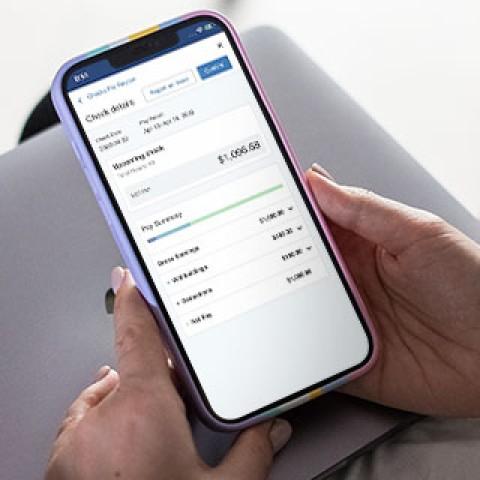The frequency with which you choose to pay your employees is an important business decision. That's because doing so requires that you maintain compliance with tax and labor laws, consistently meet payroll obligations, and ensure that everyone in the business has the same expectations around payday.
Whether you're determining a pay period for a new business or considering changing your company's pay schedule, read on to learn what pay periods are, how pay periods work, common types of pay periods and some advantages and disadvantages of each, and more.
What Is a Pay Period?
You know that you have to pay employees, but what is a pay period? A pay period or pay cycle is a regularly scheduled duration of time when workers earn wages that will be paid to them on their next paycheck. Each pay period has a start date, an end date, and, generally speaking, when one pay period ends, the next one begins without interruption.
Companies may typically choose from different kinds of pay periods, including weekly, semimonthly, biweekly, or other cycle frequencies. Some companies may also choose to have different pay schedules for different kinds of employees, such as one type of pay period for salaried employees and another for hourly workers.
Pay Periods vs. Pay Dates
When talking about paying employees, two important terms to keep in mind are pay period and pay date. So what's a pay period vs. pay date? A pay period represents the period where an employee actually earns wages and typically ends a few days before the pay date, whereas a pay date is when paychecks are distributed or earnings are deposited into employee bank accounts. It's also usually the date that appears on an employee's paycheck or pay stub. Allowing for a few days between the end of a pay period and the pay date gives employers time to gather employee hours worked and process payroll.
Keep in mind that the state(s) in which you operate may have certain pay requirements, such as the number of days within which an employee must receive payment for earned wages after a pay period ends.
Different Types of Pay Periods
Establishing a pay period is critical for keeping the business on track when it comes to reporting and paying taxes, setting the workweek for purposes of calculating overtime for non-exempt employees, and maintaining compliance with applicable payroll and tax laws. Generally, a business can choose which pay period makes the most sense for their business, as well as whether they want to simultaneously implement different pay periods for different groups of employees.
When deciding how to pay employees, consider the following different types of pay periods and how you may leverage one or a few of them at your business:
Weekly Pay Periods
How do weekly pay periods work? A weekly pay period means that a business has 52 pay cycles per year. Employees are paid on the same day each week with a weekly pay schedule, such as every Thursday or Friday. A common pay frequency, weekly pay is more popular in smaller businesses, according to 2020 survey data from the U.S. Bureau of Labor Statistics (BLS), and is most often found in the construction, manufacturing, and trade, transportation and utilities industries. In these and other industries where employees may frequently work overtime, a weekly pay cycle that aligns with the workweek makes tracking this information relatively straightforward. Employees who are paid weekly may also have high levels of engagement and work satisfaction since weekly pay offers steady cash flow.
A potential disadvantage of weekly pay is that it can be costly and time-consuming to run payroll, ensure proper tax withholdings, and administer benefits 52 times each year. Additionally, there's an increased likelihood of errors with 52 pay periods than under some less frequent pay periods, such as biweekly with only 26 pay periods, this is where an experienced payroll provider can help mitigate pitfalls.
Biweekly Pay Periods
The BLS survey revealed that a biweekly pay schedule was the most common payment frequency in the private sector, finding that 43 percent of businesses in the U.S. paid their employees biweekly. In a biweekly pay schedule, employees receive a paycheck every two weeks, totaling 26 paychecks per year (some years will have 27 paychecks). There are some months where a biweekly pay period means that employees receive three paychecks in one month. In such cases, this could certainly delight your staff, but it could be challenging as far as tracking and projecting cash flow on these "extra paycheck" months.
Semimonthly Pay Periods
Semimonthly pay periods mean that employees are paid twice per month, totaling 24 times per year. With this schedule, employees are paid on the same days each month, such as the 1st and 15th of the month. If one or both of those dates fall on a weekend, the pay date is typically the Friday beforehand.
With salaried employees, a semimonthly schedule is relatively simple to administer since payroll is run on the same dates each month and paycheck amounts are typically the same each pay period. Benefits administration and payroll tax responsibilities can also be fairly easy to administer. However, it can be more challenging to accurately pay hourly and other non-exempt workers for regular hours worked and overtime, since semimonthly pay periods are an irregular length and don't always align with workweeks.
Monthly Pay Periods
How do monthly pay periods work? In a monthly pay schedule, employees receive one paycheck per month, which is issued on the same date every month (usually the first or last day of the month). This totals 12 paychecks per calendar year. Running payroll less often is advantageous for employers, since the process can be relatively easy to manage, potentially saving the company time, money, and resources. However, it may be more complex to administer if you have hourly employees, and your state may not even permit this pay schedule for non-exempt workers. Additionally, a monthly pay period can put a strain on employees managing their cash flow, since so much time goes between pay periods.
Fixed-length Pay Periods
This pay period type allows you to specify your pay periods by a number of days per period, not by any calendar date. With this flexibility, the number of pay periods per year is variable. Fixed-length pay periods are most common in education, where many staff members don't work in the summer. This type of pay period gives teachers the option to receive payment according to the biweekly pay standard, or receive their annual salary distributed over 21 pay periods with the additional five pay periods paid out in a lump sum. States may have specific rules around fixed-length pay periods, so make sure to check with your state labor department before making any decisions about this pay cycle type.
Custom Pay Periods
A custom pay period is any non-standard period of time outside the weekly, biweekly, semimonthly, or other typical pay schedules. You may need to process payroll based on a custom pay period if an employee is terminated, for instance. But be mindful that you issue final paychecks and run custom pay periods in accordance with any applicable state and local laws (there is currently no federal law around issuing final paychecks). Depending on where your business operates, state and local law may dictate whether you have to pay terminated employees immediately or within a certain timeframe after their last day.
Instant & On-Demand Pay
While uncommon, instant or on-demand pay has emerged as workers are increasingly looking for more immediate access to their earned wages. Instant or on-demand pay services allow staff to access income as they earn it (typically up to a certain dollar amount each pay period) for a flat, per-transaction fee, rather than waiting until the business's next payroll cycle. This type of setup can be particularly appealing to temporary or seasonal workers, particularly as those positions have become increasingly difficult to recruit for in today’s labor shortage.
Anytime access to earned wages has obvious advantages for employees. Workers may experience less financial stress and feel more satisfied at work if they have the option of accessing some or all of their earned wages prior to their scheduled payday.
Employers who choose to offer this type of pay, could have employees with up to 365 transactions per year (366 on leap years). For employers, daily pay requires time and resources when it comes to implementing and administering such a pay frequency. It can also quickly become complex, particularly if you're processing payroll on your own. Consider how the business could handle calculating one-off tax withholdings, processing pay in a very short time span, handling garnishment payments if the employee has already withdrawn their wages, and other factors.
How Are Pay Periods Determined?
While it's generally up to you as the employer to determine what the company's pay period(s) will be, you need to also be mindful that the business is following federal, state, and local laws.
Federal law dictates that you must keep a consistent pay frequency for the entire calendar year. You may choose different pay periods for different groups of employees, but these frequencies must stay consistent. At the state level, many states have laws around pay periods. While some states set a minimum pay frequency, others have more in-depth rules, such as employees must be paid every X days. Learn about payday requirements in the location(s) where you operate, as outlined by the Wage and Hour Division of the U.S. Department of Labor.










